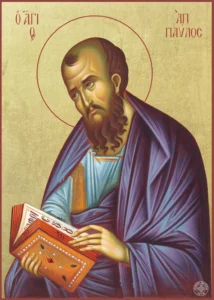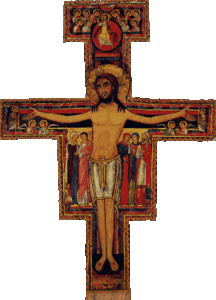Feast of the Exaltation of the Holy Cross – September 14th
Today we celebrate the Feast of the Exaltation of the Holy Cross. The origins of this feast are not very clear, but it can be said that there are at least three events that are remembered in this celebration. First, according to a tradition, it is the date in 326 when Saint Helena discovered the true cross that was buried in Golgotha. Before the liturgical reform, on May 3 there was a festival called “the invention of the Cross,” from the Latin invenio, that is, to discover, but now some say that the Exaltation of the Holy Cross took its place. Second, according to history, today is the date of the consecration of the Basilica of the Holy Sepulcher in the year 335, and in the year 347, they began a rite in which the bishop or patriarch raised a relic of the true cross for the veneration of the village. In Latin, exaltare can be translated as lifting, hence, the name of the festival, the exaltation, that is, the lifting or raising of the cross. Third, according to tradition, the recovery of the Cross by the Emperor Heraclius in 628 from the hands of the Persians is celebrated. It is said that the following year, when Heraclius carried the cross to Jerusalem, he did so dressed in all his riches. He had thought of going through the same gate from which Jesus passed, but due to a miraculous force (either by the stones which repulsed him or by a divine impulse), he could not enter the city. Either an angel or a bishop told him: “Prince, the wealth that you wear is not in accordance with the poverty of Jesus carrying the cross. He wore a crown of thorns, you crown of gold. He walked barefoot and you in luxurious shoes.” Only after removing his finery, and thus stripped of wealth, he was able to enter the city on September 14, 629.
So discover, raise, carry. We can say that these are the three actions with the cross that are celebrated today. Discover the cross with Saint Helena, raise it with the patriarch, and carry it as a treasure far from its enemies to be with those who love it. Discover, raise, carry. They are also three actions that we must do in our lives, so, briefly, I want to meditate on these actions, using the texts of a great missionary, religious, and martyr, who had a great devotion to Mary, that is, someone who really can be a model for us. That saint is Saint Maximilian Kolbe. Discover, raise, carry: we can say that these are the lessons of the cross.
The first thing we must do is discover the cross. It may seem a little strange that they lost the cross, but in reality, the Christians had hidden it to avoid the destruction of such a precious relic during the anti-Christian persecution. According to tradition, the cross was stored with the crosses of the two thieves, and Saint Helena was able to recognize the true cross for three reasons: it was in the middle of the other two, it had the inscription, but, and more importantly, a single touch of that cross performed miracles: it gave sight to the blind, life to the dead, and other such miracles.
Here, then, lies the key: the true cross gives life. That was the experience of the Jews in the desert in Mara, as recounted in the book of Exodus (15: 23-25): “When they arrived in Mara, they could not drink the waters of Mara because they were bitter. Hence they named the place Mara. The people murmured against Moses saying, “What shall we drink?” Then Moses cried out to the Lord, and the Lord showed him a tree. He threw it into the waters, and the waters became sweet. ” A touch of the cross gives life, and everything becomes sweet.
But it is only the cross of Christ that does that. Writing to one of his friars about a religious, Saint Maximilian said: “It comes as no surprise that this soul, continually taken up in a restless effort to fulfill its own will, is constantly burdened with crosses and sufferings that obtain no merit.” There are many possible crosses in this world; there are many things that we may have to suffer. But, as on Calvary there were three crosses, and only one, that of Christ, gave salvation, there are many possible crosses, but only the one that God has for us gives life.
What are the crosses that are not Christ’s? They appear in the life of each person, but they are the temptations of the devil rather than a cross. It can be an attachment to my way of doing things, to my way of thinking or seeing, to my preferences or tendencies; it can be an unfair correction, an insult or misunderstanding with another person, a superior who seems to not like me or help me. These things can be little crosses; they can be like splinters from the cross of Christ. The problem is that many times to these sprouts we give the fertilizer or, rather, the manure of self-consolation when we do not get what we want or think we deserve, and the cross grows, true, but it is not the cross of Christ. It is a mutant hybrid, an invader in the garden of our souls that destroys the flowers of virtues.
How do we come to recognize the cross of Christ, that is, how can we discern the difference between the cross of Christ and an imitation? We need humility. It can be humility in the examination of conscience, humility in speaking with the spiritual director, confessor, or superior, it can be the humility of receiving directions, corrections, whatever, without fighting. What is certain is that humility is the true fertilizer. In the same letter to his friars, commenting about these hurried souls, Maximilian laments that “one of the features of [these souls] is a clear lack of humility. Haughtily trusting in its own intelligence, it does not even accept the reproach of superiors, but writes it off as dislike and prejudice on the part of the superiors.”
In a particular way we live humility through obedience. In a retreat, Saint Maximilian wrote in his notes, proposing an exercise to grow in obedience: “Every time you make the sign of the Holy Cross, remember obedience:
1
3—5—4
2
1. Submit your judgment;
2. Your heart, your will;
3. And (4) your shoulders to support the weight of the work for the glory of God, for the good of the Order, of the Church and of the salvation of souls;
5. Amen = may it be so indeed.”
Then, through humility, we can discover the cross of Christ in our lives. Once discovered, we have to raise it. We know that the true crosses are those that Christ sends us so that we can grow in holiness. In this way, raising the cross in our lives is like raising a building, or building a house. For us, it means raising up a life that is an imitation of Christ Crucified. In a very beautiful way Saint Maximilian writes: ““Study the Crucified Christ… Make yourself like Him. . . . The imitation of Jesus Crucified requires lengthy training that must start from the way one perceives and considers oneself, namely from humility.” Discover the cross in humility, and then raise the cross.
Again and again, Saint Maximilian speaks of the cross as the school of love. In a letter to his brother, he says, “Submitting to the will of God and its implementation, especially in what is contrary to the senses and even to a limited and fallible intellect, inflames one’s love for God even more. The cross is the school of love.”
The saint explains that the cross is a school of love precisely because it works to purify our love. He ends a letter to his brother saying: “I shall conclude with the hope that the Immaculata does not withhold crosses for her Militia and for each one of its members because of it; only in this way, in fact, are intentions purified, with the result that we do not belong to the Militia or work in it for our own ostentation or self-satisfaction, but only for pure love.”
This purified love allows us to use the crosses like so many ladders, to rise to the top of perfection. To a missionary in Japan, he wrote: “I know there will be no shortage of setbacks, much less of crosses, possibly even very heavy ones, but [Mary] can do everything. I write this from personal experience. The crosses are only a school; they add merits. They oppress us, but at the same time elevate our spirit and teach us not to rely on our own deceptive strength, but only in the Immaculata: God, therefore, sends them to us out of mercy.” The crosses raise our spirits; they raise us up because they train us in the school of love that is Christ Crucified. Then, we discover the cross of Christ in humility; we raise a masterpiece when we study in the school of love that is the cross, and thus the cross lifts us up, and now we have to carry the cross. That means carrying it every day, with love, because in this way we find much more than we sacrifice.
This was understood very well by Saint Maximilian. In one of his notes for a day of retreat, we read: ““If any man would come after Me, let him deny himself, and take up his cross, and follow Me.” [Mt 16:24].” But later, he adds, in italics: “that is the indispensable condition.” Deny yourself, and take up your cross: that is, as we said: discover the cross, raise it up, and then the religious life truly begins.
But, in conformity with Christ, the cross is converted. It becomes the happiness and measure of our love. As he wrote on another occasion: “Love the crosses. Cross, cross, cross = (equal symbol) source of true happiness. ” Or, elsewhere, he wrote, “Love knows no limits,” and, in his notebook, he put a red cross over the word love.
Again, to a priest, I reminded him that happiness is found on the cross, because the cross gives life to love: “It is said, “Per aspera ad astra.” Certainly, whoever works for the Immaculata must suffer much. And the Immaculata also suffered much. Love is nurtured precisely with the crosses. We are all very inadequate, but also very happy—is it not true?—instruments in the dearest hands of our Mother.”
It is a very realistic vision, but very in love with the cross. Therefore, to the missionaries in difficulties he said: “I plead that you not worry when troubles come, but give everything without limits to the Immaculata, do what you can peacefully, be confident, and put unlimited trust in her.”
Saint Maximilian knew that crosses are inevitable in this world. If there were no crosses in this world,” he said, “there would be nothing to earn us paradise. Crosses, either internal or external, are indispensable.”
But for him, crosses are a gift from Mary: “But do not shy away from experiencing sorrows either, if she is the one sending them to us. No place on earth will ever be completely free of crosses: if we had no crosses, we would not have the chance to gain heaven. Therefore, let us not try to avoid the cross too much, and if we need to take it on our shoulders, let us carry it willingly out of love for the Immaculata.”
In the end, by carrying the cross well, we reach the perfection of love: the saint says “The summit of love is the state in which Jesus came to find himself on the cross when he said: “My God, my God, why have You forsaken me?” [Mt 27:46; Mk 15:34]. There is no love without sacrifice. Sacrifice of the senses, especially the eyes, especially when one leaves the friary and goes among the seculars; sacrifice of taste, hearing, and so on. But, above all, the sacrifice of the intellect and the will in holy Obedience.” The summit of love is the sacrifice of everything, but, at the same time, it is there that everything is found.
In the end, the saint concludes: “The source of happiness and peace is not outside, but within us. Let us learn how to profit from everything in order to exercise our souls in patience, humility, obedience, poverty, and the other virtues of religious life, and the crosses will no longer be so heavy. After all, we proclaim that through the Immaculata we can do anything: let us then prove it with facts. Let us place our trust in her: let us pray and go forth in life with peace and serenity.”
So, discover the cross in humility, raise the cross in our lives out of love, and carry the cross with love, peace, and happiness. These are the lessons of the Exaltation of the cross, and we ask through the intercession of Mary, the Mother of Jesus who is always at the foot of the cross, the grace to live the lessons of the cross in our lives.






